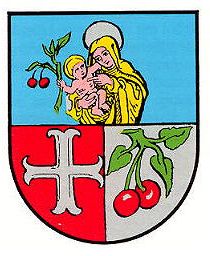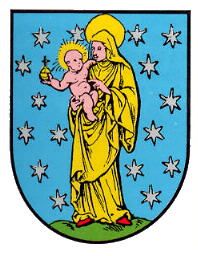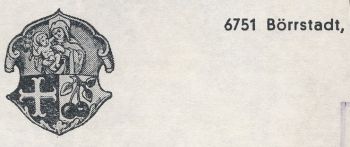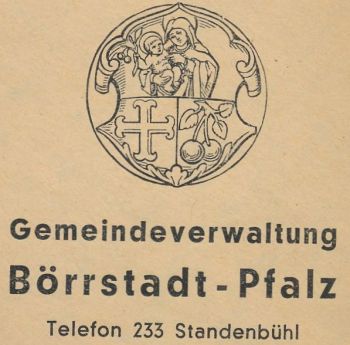Börrstadt
BÖRRSTADT
State:Rheinland-Pfalz
District (Kreis):Donnersbergkreis
Verbandsgemeinde:Verbandsgemeinde Winnweiler
| German |
Geteilt und unten gespalten; oben in Blau eine wachsende Madonna in goldenem Gewand mit Kind, die Mutter silbern nimbiert, der Sohn golden, er trägt einen Kirschzweig in der rechten Hand; unten rechts in Rot ein silbernes Tatzenkreuz, links in Silber zwei rote Kirschen an grünem Zweig. |
| English | blazon wanted |
Origin/meaning
The arms were officially granted on March 23, 1931.
Historically the village was divided in Ober- and Niederbörrstadt, which each belonged to different overlords and each had its own court and (probably) seals. The seal for Oberbörrstadt showed St. Mary with Jesus who holds an orb in his hand, is known from 1750 until 1818.
In 1839 the (now unified) municipality used the image of the seal of Oberbörrstadt as its arms. The colours were defined by Otto Hupp as the colours of Nassau (blue and gold), as Oberbörrstadt historically belonged to Nassau-Weilburg. These arms, see below, were used until 1931, but were never officially granted.
The 1931 arms combine elements for both former villages; the upper part is based on the previous arms and a silver cross is red was added for Noederbörrstadt. As cherry cultivation was of importance for both villages, cherries replaced the orb in the upper half and were added in the lower half.
The cross for Niederbörrstadt is taken from the arms of the territory of Dalberg, to which the village belonged in the 19th century.
| The arms from 1839-1931 | |
| Municipal stationery, 1960s |
Municipal stationery, 1960s |
Literature:Debus, 1988
This page is part of the German heraldry portal Deutsche Wappensammlung |
Heraldry of the World |
|
German heraldry:
|
Selected collector's items from Germany:
|
Contact and Support
Partners:
Your logo here ?
Contact us
© since 1995, Heraldry of the World, Ralf Hartemink 
Index of the site















